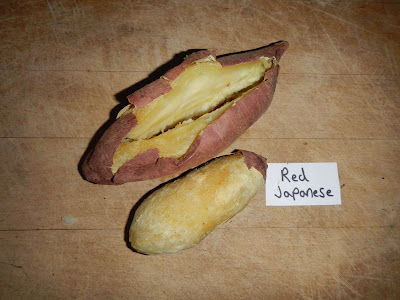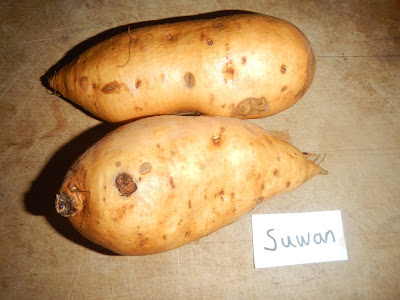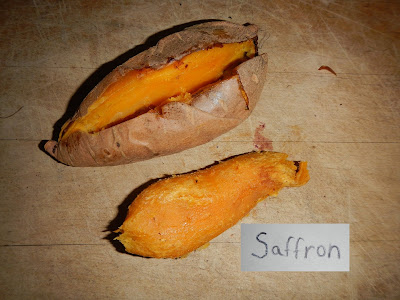[We wrote this a couple years ago but forgot to post it here to our blog until now]
Last year we wrote about seven
reasons to support local-organic grain farming. In response
to what we wrote there one of our customers asked us why we had said
that local-organic grain for human consumption mainly needs to
precede local-organic grain production for animal feed and why we
wouldn't get very far at all the other way around. Here, more or
less, is our answer to that question, which we hope will be of
interest to some of you as well, particularly if you've ever
lamented the very substantial compromises to local-organic methods
practically always involved with pork and poultry, even from local
farmers that grow other things organically. (Cattle are sometimes
an exception because they can be raised entirely on grass, which
swine and poultry can't be. Sheep and goats raised for market
practically always fall far short of local-organic practice, even
though they can be raised entirely on grass and browse.) We hope
our response will deepen your understanding of the hurdles to a more
complete local-organic food system and motivate you to help overcome
those hurdles, particularly by buying local-organic grains to eat.
These issues are complex, especially if you're a consumer trying to
decide what to eat without the benefit of knowing and trusting any
farmer well enough to let your consumer choices follow his lead.
The easy solution is just to content oneself with some "non-GMO" or
"pastured" window-dressing on farming which isn't really the least
bit local or organic at all (or just to abandon local and organic
pretenses altogether), but if you want more than just superficial
organic window-dressing on your pork or poultry..., here's our
attempt to explain why the grains you eat yourself will have to come
first.
Perhaps the most important reason we don't see any realistic path
to local-organic pork or poultry that doesn't begin with
local-organic grain for human consumption is that farmers would have
to convince customers to care about it and pay for that
local-organic feed, and we really can't see consumers caring about
(or even understanding the production facts of) the grain they eat
indirectly as animal products if they haven't yet even changed the
grain they put directly on their own plates. And the same would be
true for the farmer that would grow the grain. Presumably before
any farmer would try to sell the value of local-organic feed grain
to his customers, he'd have to be convinced of the value of it
himself, but think about the kind of farmer that would grow his own
feed grain without herbicides, etc.: what would motivate him to hand
hoe those rows of corn instead of using herbicides (not that corn is
a complete feed anyway; the high protein component of any complete
feed would very likely be even more challenging)? If he valued
local-organic food and farming, would he feed that hard-won,
homegrown grain to his animals while he kept on buying his own grain
from the supermarket (or other retailer selling grain from the same
sources as the supermarket)? Quite simply, people are going to come
first and then farm animals.
But to explore the details beyond that basic point, consider that
even if a local farmer could grow a particular grain efficiently
enough to compete with commodity-organic prices, he wouldn't be able
to maintain that efficiency on a scale as small as the local-organic
market potential, and even if he could grow it price-competitively
on a scale appropriate to local markets, there's no single grain
crop that can efficiently serve as a complete animal feed, and there
would be very substantial added costs to processing grains for feed
(normally including extracting oil and using the leftover oil seed
meal for animal feed), so the unavoidable reality is that
local-organic grain means taking on additional costs that would make
it impossible to compete even with commodity-organic feed, let alone
the cheapest conventional feed on the market. And yet, the vast
majority of consumers that buy organically grown vegetables at local
markets, if they also buy pork or poultry/eggs at those markets, buy
from farmers feeding conventional (not even commodity-organic, let
alone local-organic) -- if their feed is non-GMO, and it mostly
isn't even non-GMO, it's mostly just feed made from 100%
conventional ingredients for which genetically modified options just
aren't on the market yet -- which goes to show how great the cost
pressures are and how little it takes to displace local-organic
practices in the marketplace. If a farmer believes in local-organic
agriculture, there are things he can do for himself, things that
were commonly done by most farmers until not that long ago, to raise
local-organic pork or poultry, but getting customers to understand
those things, appreciate the differences, and trust the farmer to do
things that don't make sense to agriculturally illiterate consumers
(or very minimally literate and easily misled, even by selective
facts that are completely true) is the huge hurdle, especially if
customers are mainly price (and convenience) shopping based on just
an assortment of a few of the buzz words ("pastured,"
"hormone-free," "non-GMO," etc.) that farmers can offer without
growing any of the feed their animals eat (or even so much
as having a clue where the feed was grown.) ("Pasture" can
potentially play a significant role in the feed of swine or poultry,
but most often its feed value is completely insignificant.)
And the cost differences between local-organic and conventional
grain are compounded by using grain for feed. If our farm sells
grain for human consumption for around $2/lb (or a little more for
milled/processed grain products) we might be about double the price
of conventional (non-organic) counterparts at the supermarket but
fairly competitive with USDA-organic supermarket prices (largely by
being able to cut out all the processors and distributors and
retailers that commodity farmers have to support.) But unlike
supermarket options, at $2/lb most of our cost is in actually
growing the grain. There would certainly be some savings to not
having to keep our grain food grade and being able to use it in bulk
for animal feed, but on a small (direct market) scale we'd still
have to put our cost of growing grain as animal feed at or above
$1/lb (compared to about 50c/lb for commodity organic whole corn we
could purchase by the ton), and if you compare that to conventional
grain prices (less than 10c/lb), that's over 10 times the price
(and, again, that's without considering the likely more challenging
high protein part of a complete feed.) Put simply, local-organic
grain products for human consumption can compete much better on
price with their counterparts than any animal products raised on
local-organic grain can compete with their counterparts. So there's
a whole lot of pressure there to keep feed costs down, and before
farmers (and consumers) bear those greater costs for the sake of
what they're only going to indirectly eat (animal feed), we can't
imagine they wouldn't first pay the smaller costs for what they
would eat directly (as food).
But one excellent way to minimize the costs of animal feed would
be to utilize the byproducts of growing (and milling) local-organic
grain for (human) food. There are lots of ways this can come up.
When we run our wheat through our seed cleaner to get out weed seeds
like rye grass and small bits of chaff, etc., probably 5% or more of
our wheat (smaller and broken kernels) gets sifted out along with
the rye grass and chaff. With our corn significantly more grain
gets culled as animal feed. We definitely err on the side of
culling hard, but even in a good year we're probably culling close
to 25% as animal feed. In 2014, when crows pecked into the ends of
the ears letting rain into the shuck we wound up with a whole
planting that just went to animal feed. There are also
opportunities to fence animals in to self-harvest crops that have
lodged or otherwise failed. Mostly piggybacking the grain needs of
pork or poultry onto grain crops grown primarily for direct human
consumption can go a long way to making local-organic pork and
poultry relatively economical.
But we don't mean to over-emphasize the need for feed grain in a
local-organic context, especially not grain grown intentionally for
animal feed, because small diversified farms can utilize a lot of
other different surpluses, byproducts , forages, etc. in feeding
poultry and swine and really minimize the need for grain, even
completely do without at times, but we think grain will inevitably
be the feed that fills in the gaps between all those other feeds and
forages. But those other feeds and forages are going to quickly
become impractical and uneconomical as farms scale up and
specialize. For example, it's one thing to feed lettuce to the
geese that's wilted or is starting to bolt, but it's entirely
uneconomical to coordinate with and drive to a produce farm to get
lettuce to feed to geese. Similarly, it's a whole lot easier to
feed one's own cull watermelons or pumpkins to the hogs than it is
to get a farmer to get another farmer to coordinate any collection
(especially anytime besides just the week after Halloween, and such
pumpkins wouldn't come from organic farms anyways) and get them to
the farm where the hogs are. In other words, the less specialized a
farmer is, the more alternative options (besides grain) he's likely
to find practical for feeding swine or poultry.
But these ways of making local-organic animal products (like pork
and poultry) more economical aren't going to happen when customers
shop superficially item by item and farmers position themselves to
serve that kind of market. Buying USDA organic flour that was grown
in and around Kansas and pork that was raised locally on corn grown
in Ohio and soybean meal from an oil processing plant in Indiana
from soybeans grown in five different states (none of which is North
Carolina) and buying pumpkins from one non-organic North Carolina
farm and apples from another non-organic farm and buying sweet
potatoes from one local-organic farm and USDA-organic tomatoes in
December from Mexico... leaves none of those farms with an
assortment of surpluses to economically feed a good, mixed diet to
some pigs, nor does it leave those surpluses with the kind of
farmers that would be interested in small sideline production
anyways, and so the only options for pork (or chicken) that
customers find anywhere on the market are options raised on
commodity corn-soy (or similar) type mixes, certainly nothing like a
diet of apples and acorns and pumpkins and heirloom corn and
cheesemaking whey, etc. That's not because those options couldn't
be economical, only that they can't be economical unless farms are
more diversified. But the only realistic way for farms to really
diversify is if they can find a way to sell a wide assortment of
products (tree fruits, garden crops, grains, dry beans, lumber,
nuts, dairy, etc.), without having to compete superficially (mostly
just on price) item by item, which is a sure way to force farms to
specialize in order to survive. So that's the answer we see to
local-organic pork and poultry (and eggs), and we see local-organic
grains for human consumption as an essential and hugely important
piece of that puzzle.
Thursday, August 16, 2018
Tuesday, August 14, 2018
Thursday, July 5, 2018
Wheat harvest
We were glad for a good wheat harvest this year. We grow an heirloom soft wheat called Red May and a modern hard wheat called NuEast.
Tuesday, June 12, 2018
Friday, April 20, 2018
Monday, March 19, 2018
Homegrown oatmeal
 |
| We're excited to be eating our own oatmeal these days. The first step in getting a bowl of oats is to run the oats through a roller. |
Monday, February 19, 2018
Subscribe to:
Comments (Atom)

































































